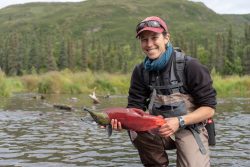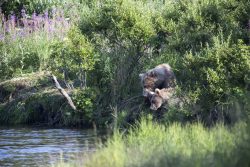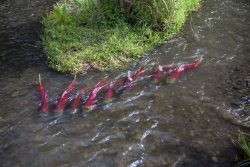In a world where valuable natural resources can be scarce, nature often loses when humans set their sights on something they want. But a new study published in the journal Ecological Applications shows that doesn’t always have to be true. Researchers found that with proper management of salmon fisheries, both humans and bears — who depend on a healthy supply of the fatty, oily fish — can thrive.

“We hear lots of stories about how fishing is decimating our oceans, and how humans are competing with wildlife,” says lead author Alexandra Lincoln. “This gives us some optimistic news instead, and highlights that if we have enough data to carefully manage fisheries and healthy habitat, we can manage a fishery to meet the needs of both wildlife and people.”
Building on a nearly two decade-long dataset, Lincoln and her colleagues looked at the relationship between wild brown bears and their staple food source, sockeye salmon in Alaska’s Wood River and Iliamna Lake watersheds. This vast network of forests, mountains, streams and rivers empties into Bristol Bay to support its world-famous salmon fishery. With intense fishing pressure on this delectable ocean-going fish, the question of whether enough fish return to the system to not only spawn — critical for supplying the next generation of fish — but also feed hungry bears is critical. Good news according to the data: yes, there is.
One of the study’s key findings shows a repeating pattern over the years of bears reaching a saturation point in terms of feasting on salmon. In other words, researchers found that bears often reach a point of satiation, and that adding more fish into the system doesn’t translate to bears eating more. And because there is no shortage of fish, the bears in many cases eat only the high energy good stuff, like the brains, bellies, eggs or the giant hump that develops on the backs of male sockeye during spawning.
“I was surprised at how regular that pattern of saturation was,” says Lincoln. “Seeing how picky these bears can be and all the leftovers, it’s hard to believe that bears would be starving and leave all these fish bits everywhere.”

It’s important to note that scientists did not see satiation occur in all years, but that doesn’t necessarily mean the bears go hungry. “Bears often forage in areas containing several adjacent spawning streams, allowing them to move back and forth among neighboring streams over the course of a day or two,” says Aaron Wirsing, professor of environmental and forest sciences and a project lead. “Thus, bears without enough food on one stream often have better fishing options nearby.”
The Wood River and Iliamna Lake watersheds are a rare place where scientists can isolate the effects of fish harvest on the health and wellbeing of bears. The watershed is relatively untouched and massive, and the study sites scientists visit are not shared by other salmon species besides sockeye. Brown bears are the major top predators in the region as black bears and wolves are rare. With only one dominant salmon species, and one dominant predator, scientists can determine cause-and-effect more precisely than in other systems where they may be other complexities.
“We can’t apply all of what we’ve learned to all systems,” says Lincoln. “This fishery is data rich” which isn’t always true for other heavily managed ecosystems that produce goods that people want. That wealth of data contributes to the success of what is regarded as one of the best managed fisheries in the world — the Bristol Bay Sockeye Salmon Fishery — and continued data collection gives researchers the ability to use decades-old data to connect management to parts of the ecosystem like brown bears.
Scientists from UW and elsewhere have been studying these watersheds for over 70 years through the Alaska Salmon Program, and collecting brown bear data for nearly 20. Under the direction of Tom Quinn, a professor of aquatic and fishery sciences and one of the Alaska Salmon Program’s lead scientists, researchers walk several creeks every day during spawning season counting salmon. They count alive fish, dead fish and fish that have been killed by bears or seagulls. They note the condition of the salmon carcass — is there just a bite of the belly, or has nearly the entire animal been consumed? This level of detail, and the time series over which the data were collected, was key to uncovering the insights they published. “Leveraging two decades of work offered us a unique opportunity to explore patterns of bear predation in relation to the ebb and flow of salmon availability,” notes Wirsing.

“Over the 20 years, we’ve counted something like 325,000 dead fish,” says Lincoln. “Some days we’ll count 10,000 live fish in a stream 2 km long. Seeing a stream chock full of fish, with wall-to-wall red salmon backs sticking out of the water, is a highlight of this work.”
Lincoln received her master’s degree at the UW School of Aquatic and Fishery Sciences working on bear-salmon interactions in Alaska, and now brings her expertise working as a senior ecologist with King County.
Get a feel of what it’s like to be a scientist collecting data in the salmon streams of the Wood River watershed in UW’s previously published story A Living Laboratory.

